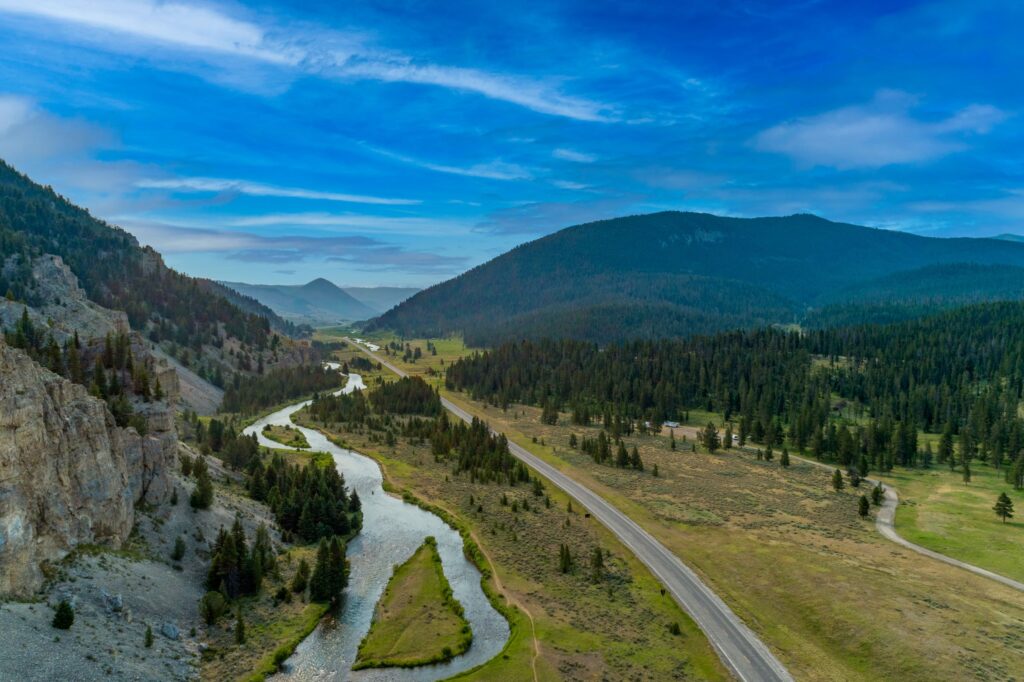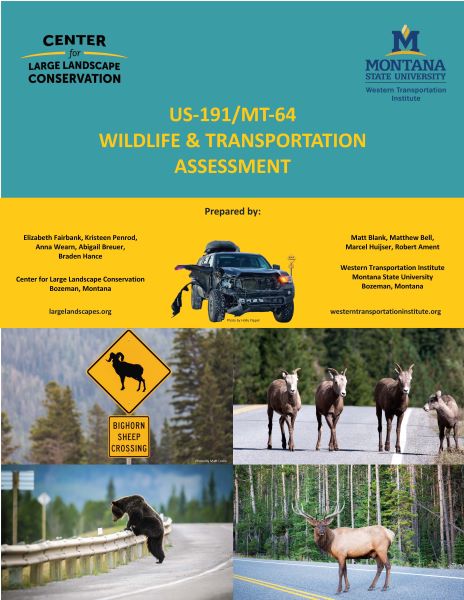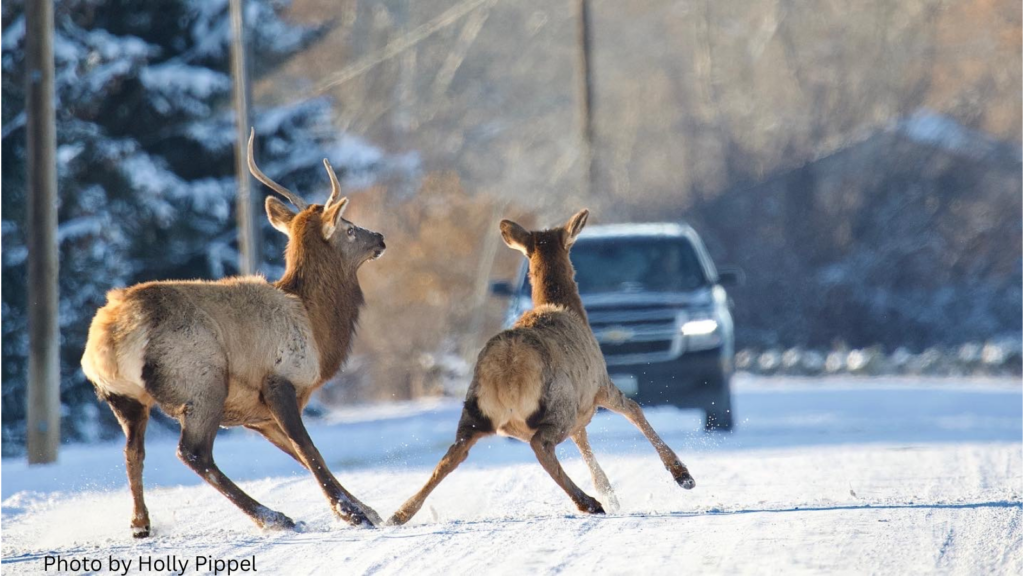Assessment Recommends 11 Priority Sites for Wildlife Crossing Structures or Other Measures
NEWS RELEASE
September 28, 2023
Bozeman, MT ─ The Greater Yellowstone Ecosystem is home to the largest concentration of wildlife in the lower 48 states. But as the numbers of area residents and annual visitors have grown, so has the incidence of wildlife-vehicle collisions. On US Highway 191 (US-191) through and around Yellowstone National Park, large mammals like elk and deer are hit with increasing frequency and rising traffic volumes make it harder for wildlife to access habitat on either side. To address these problems, a team from the nonprofit Center for Large Landscape Conservation (CLLC) and Montana State University’s Western Transportation Institute (WTI) embarked upon a two-year study to better understand wildlife movement and improve road safety along this busy route.

The US-191/MT-64 Wildlife & Transportation Assessment, which was published today, identifies 11 “priority sites,” where highway mitigation measures—such as culverts, underpasses, overpasses, animal detection systems, traffic-calming measures, and fencing—could improve the safety of travelers and wildlife.
US-191 between West Yellowstone and Four Corners, Montana, winds along the Gallatin River and passes through national forest and national park lands, providing travelers access to Yellowstone National Park. MT-64 (Lone Mountain Trail) leads to the community of Big Sky along the way. The Montana Department of Transportation and Interagency Grizzly Bear Study Team documented 1,322 animal carcasses from 2011-2020 in this study area. According to estimates from a recent national study, these collisions cost more than $27 million in personal injury and property damage. This figure soars to over $60 million if the passive use value of wildlife—which includes the ability of species to remain on the landscape—is included.
“Collisions involving wildlife make up 24% of all reported crashes on US-191 between Four Corners and Beaver Creek.* That’s nearly five times the national average,” says CLLC Road Ecologist Elizabeth Fairbank, who co-authored the study.
“The study’s data show that we have a stretch of highway that not only poses a safety risk to people and wildlife, but also fragments habitat, all at a significant cost to the public,” explains Fairbank. “As the road’s traffic volume continues to increase, animals are less likely to be able to cross the road safely, increasing collision risk and reducing the ability of wildlife to move freely to access the resources they need to thrive and survive.”
 Dr. Marcel Huijser, senior scientist for WTI and study co-author said that the assessment team synthesized data from multiple public agencies to identify particularly troublesome areas for safety and wildlife movement.
Dr. Marcel Huijser, senior scientist for WTI and study co-author said that the assessment team synthesized data from multiple public agencies to identify particularly troublesome areas for safety and wildlife movement.
“We overlaid information on wildlife-vehicle collisions, animal carcass counts, wildlife movement, and suitable habitat, and identified sites where potential mitigation measures could improve road safety and connectivity for wildlife,” says Huijser.
Citizen scientists from local communities played a key role in the effort by reporting sightings of live or dead wildlife using a smartphone app from the Roadkill Observation and Data System (ROaDS) that was developed by WTI and managed by CLLC for the project.
“Once we analyzed the data, our research team conducted field visits with representatives of federal, state and county agencies with expertise in wildlife, engineering and transportation planning,” said Huijser. “We did this to help confirm the priority locations that would benefit most from mitigation measures to protect wildlife and motorists, and how they would fit into the landscape given the topography, streams and rivers, and land use.”
The assessment considered not just terrestrial wildlife, but also the ability of fish to pass through culverts underneath the road. The aquatic research was led by WTI hydraulic engineer Dr. Matthew Blank, who evaluated the potential “barrier effect” of 53 culverts along streams under US-191 and MT-64. Upsizing culverts to improve fish passage can provide co-benefits for other wildlife as well as make infrastructure more resilient to extreme weather events and high stream flows.
“There are often opportunities when you create larger, wider fish passage structures, to provide safe passage for terrestrial species as well,” said Blank.
The full report on the assessment is available online, and the Center for Large Landscape Conservation will share the key findings with Gallatin County residents through a series of Community Information Sessions in Big Sky, Gallatin Gateway, and West Yellowstone. Together with elected officials and public agencies, area communities will determine how to act on the assessment’s findings. If they choose to pursue wildlife accommodation measures, they could apply for federal funding through various programs, including the Wildlife Crossings Pilot Program, a competitive grant program continuing through fiscal year 2026.
Infrastructure design and implementation processes often take five years or more to make it through the programming, feasibility, design, and funding phases that are necessary prior to construction. Thus, the assessment describes shorter-term measures—that could be enacted within two to five years—as well as longer-term options for each priority site.
“This is an important first step in a long process. It is going to be a multi-year effort involving many different partners,” says Fairbank. “There is no quick fix but, in the end, a variety of measures put in place over time will make these roads safer for travelers and wildlife, while improving habitat connectivity.”
The assessment was funded by the Big Sky Resort Area District, Moonlight Community Foundation, Yellowstone Club Community Foundation, The Volgenau Foundation, and the Small Urban, Rural and Tribal Center on Mobility (SURTCOM).
For more information: largelandscapes.org/191
*Montana Department of Transportation (2020)
About the Center for Large Landscape Conservation
The Montana-based Center for Large Landscape Conservation advances ecological connectivity for climate resilience worldwide through science, policy, practice, and collaboration. largelandscapes.org
About the Western Transportation Institute
The Western Transportation Institute at Montana State University is the country’s largest university-based research center focused on rural transportation issues. westerntransportationinstitute.org
###
Contact: Christine Weinheimer, Communications Manager, Center for Large Landscape Conservation, communications@largelandscapes.org
Photos, top to bottom: Elk in oncoming traffic in US-191 – courtesy of Holly Pippel; US-191 and the Gallatin River near Big Sky, MT – Adobe Stock; US-191/MT-64 Wildlife & Transportation Assessment report cover.



